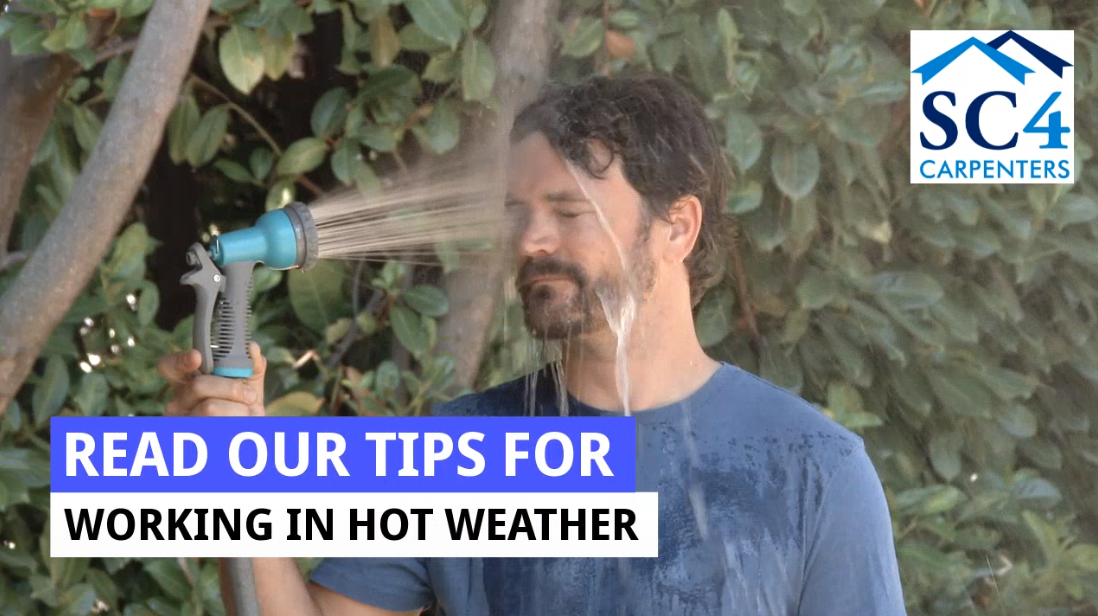
Tips for Working in Hot Weather in Construction
The hot weather can’t be avoided on a construction site, whether working indoors or outside.
Working in construction during the heat of the summer can lead to increased risk of injury from falls and other accidents and incidents as concentration wavers due to heat-related illnesses (HRI), tiredness, dizziness, disorientation or confusion. It can also result in heat cramps, heat rash, heat exhaustion, fainting and heat stroke leading to serious illness or even death.
It is therefore extremely important that everyone working in the heat takes precautions to look after themselves and others
Here are some tips on how to stay safe in the heat:
1. Your health and safety is number one: Remember that the health and safety of you and your colleagues is much more important than getting the job done.
2. Stay in the shade: If you can, plan your work to be in cooler parts of the site or work in the shade. Use fans or other ventilation if working in a hot room. Ensure you take regular breaks are in a cooler part of the site. If possible, schedule work in the early morning or at night when temperatures aren't as bad.
2. Hydrate: Start drinking plenty of water the night before work, adding electrolytes from tablets or drinking sports or rehydration drinks and remember to continue rehydrating throughout the day.
3. Pace yourself: Don’t overdo it. Make sure you and those you are working with take lots of breaks and don’t over-exert yourselves by working to strenuously.
4. Dress for the weather: Wear sports or similar light weight garments that reduce the heat load on the body. These offer trans-evaporative cooling, UV and insect protection. If not wearing a hard hat, wear a wide-brimmed hat or sun visor to protect your face. Cover the back of your neck.
5. Protect your skin: It can be tempting to wear shorts and sleeveless tops in hot weather, however, loose long-sleeved tops and trousers can keep you cool and protect your skin. Regularly apply sun block to face, neck, ears and other exposed skin.
6. Take extra care of yourself: The heat takes an extra toll on your body. Make sure you get enough sleep and eat healthily to ensure you have all your strength for the physical work you are doing.
7. Look out for the Warning Signs: Heat related illnesses range in severity and are not something you should take lightly.
First Signs – Thirst and tiredness followed by heat cramps - painful involuntary muscle. Poor hydration, fluid and electrolyte loss often contribute to heat cramps, have a rest in a cool place and rehydrate
Time to Stop for the day – If you or a colleague are experiencing any of the symptoms listed below you may have Heat Exhaustion and should:
- stop work
- go somewhere cool
- rehydrate by drinking plenty of water or sports/rehydration drinks
- lie down with your feet up
- Cool your skin with a spray or sponge them with cool water and/or a fan. You can also use cold packs around the armpits or neck.
According to the NHS, the signs of heat exhaustion include:
- a headache
- dizziness and confusion
- loss of appetite and feeling sick
- excessive sweating and pale, clammy skin
- cramps in the arms, legs and stomach
- fast breathing or pulse
- a high temperature of 38C or above
- being very thirsty
Call 999 – Heat stroke can be very serious if not treated quickly. Call 999 if you or a colleague are experiencing any of the following symptoms:
- feeling unwell after 30 minutes of resting in a cool place and drinking plenty of water
- not sweating even while feeling too hot
- a high temperature of 40C or above
- fast breathing or shortness of breath
- feeling confused
- a fit (seizure)
- loss of consciousness
- not responsive
SC4 recognises the importance of ensuring our workers are trained about the symptoms of heat-related illnesses and their prevention and that they are monitoring each other for signs of illness.
View our Health & Safety Blog for more tips on how to keep safe and healthy in construction.
Click on the categories below to find out more about:

Connect with Us
Share this Page
More Posts
Recent Posts
- Breathe Easy, Work Safe: The RPE Every Site Worker Needs
- From Site to Strategy: Simon Mead Promoted to Associate Director at SC4
- SC4 named Cala Contractor of the Month, October 2025
- Why is Neurodiversity so important in Construction?
- Our Favourite Carpentry Project Of 2024: Cromwell Court, Old Basing
- Case Study: Timber Frame Installation in Netley Grange, Southampton